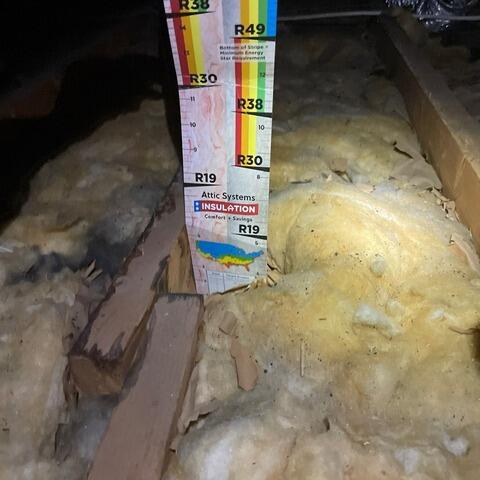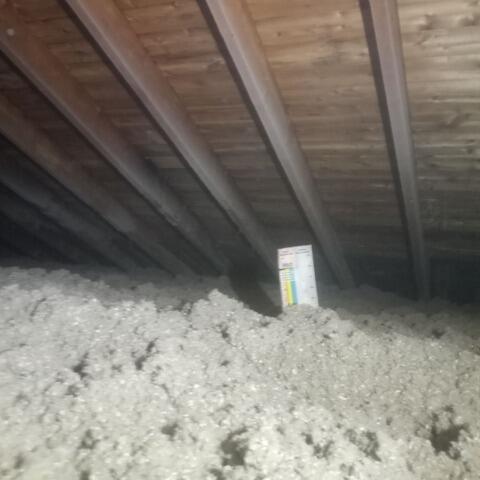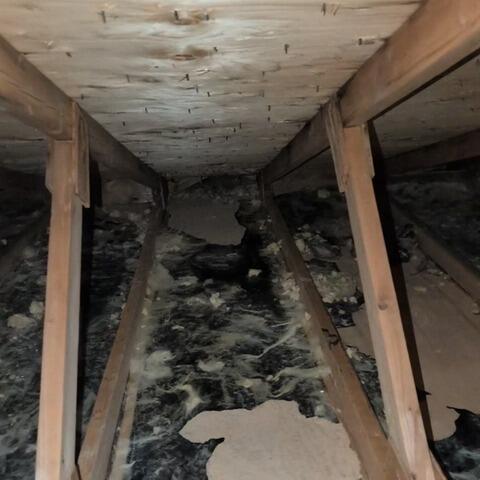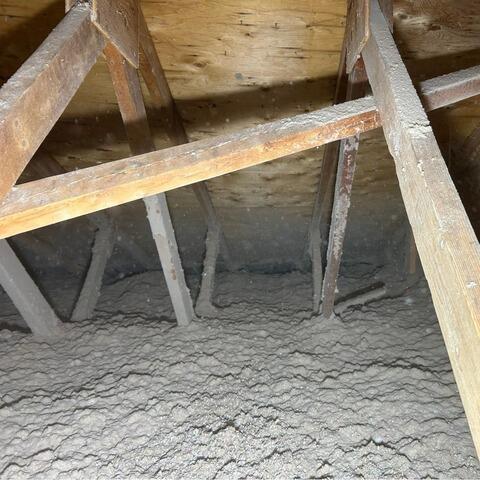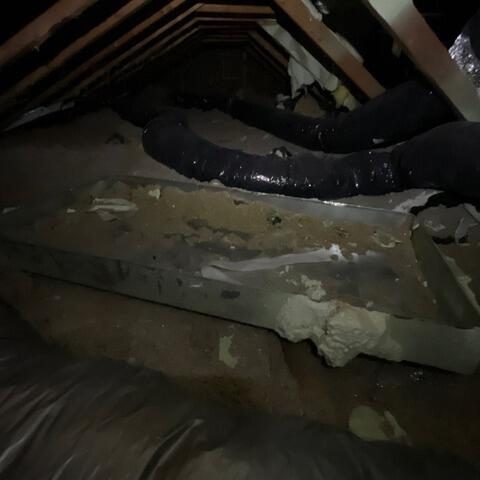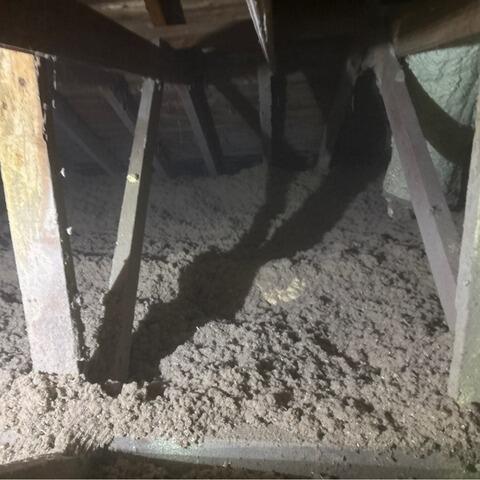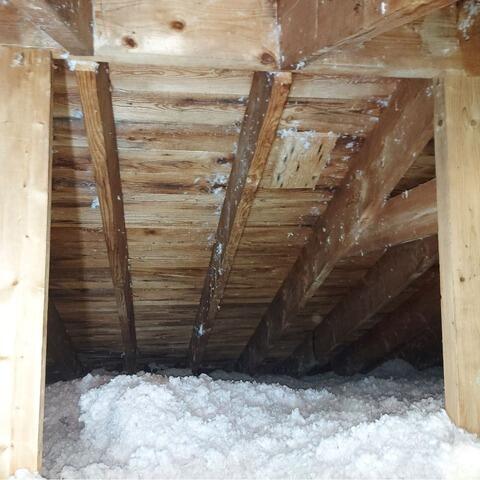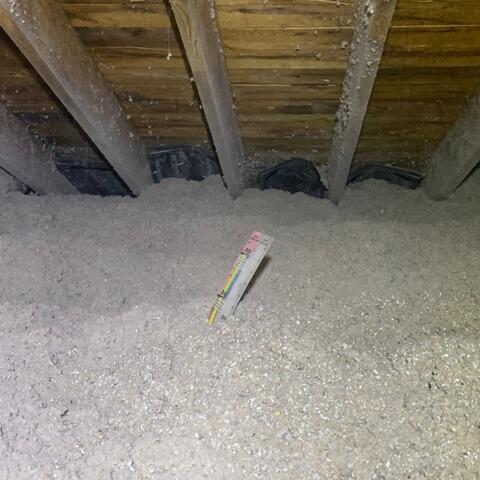Attic Insulation Before & After Photos
Click on a photo to enlarge.
Complete Attic Insulation in Saint-Clet, Quebec
Client was confused since he installed new insulation a couple of years ago, but is still experiencing uncomfortable air drafts within the house. Upon inspecting the attic, our specialist informed him that air sealing of all the leaks should have been done prior to installing the insulation. The perfect solution was to remove the existing insulation that started to show signs of deterioration due to the excess humidity. Then, a thorough inspection is done to identify an seal all the air leaks. After that, baffles were installed to regulate the ventilation within the attic, and approximately 17" of our TruSoft cellulose insulation were blown inside the attic to ensure a thermal value of R60. It is important to say that cellulose insulation can easily cover problematic spaces within the attic, and thus provide better insulating performance.
Complete attic conversion in Lachute, QC
In this Lachute residence, the owner complained of cold spots in winter, high heating bills, and a poorly sealed attic that allowed warm air to escape outside. We took action by removing the old, degraded insulation, completely caulking the crawl spaces, ductwork, and joints, and then blowing in TruSoft cellulose to ensure uniform coverage with excellent thermal resistance and optimal airtightness. This solved the energy loss problem, improved indoor comfort, and contributed to a more efficient and effective home.
Attic insulation in Gore, QC: no more moisture and mold problems
In this house in Gore, QC, the attic suffered from a combination of serious defects: sagging insulation, air leaks, persistent drafts, and, above all, significant moisture and mold accumulation. To remedy the situation, Systèmes Éconergie took action: first, the old contaminated insulation was removed, the structure was cleaned up, and the affected areas were treated. Next, careful caulking was applied, particularly around ducts, light fixtures, and openings, to eliminate air leaks and prevent moisture infiltration, an essential step that is often overlooked elsewhere. Finally, we installed TruSoft cellulose blown insulation, a dense, high-performance material that fills cavities, fills gaps, and forms a uniform thermal barrier: this cellulose, made from recycled paper, increases the thermal resistance recommended for an attic, while providing excellent airtightness and better resistance to moisture, pests, and mold.
Attic Insulation in Hinchinbrooke, Quebec
During an attic insulation project in Hinchinbrooke, Quebec, our specialist detected high moisture within the attic, which had led to mold growth. We removed all the contaminated insulation, then thoroughly treated the area using our Mold-X2 product to eliminate any mold spores and prevent them from spreading again. Once the attic was properly sealed, we installed our TruSoft cellulose insulation to achieve an R60 thermal value. This intervention improved the home's energy efficiency and also regulated the moisture issues, thus creating a more comfortable and healthier living environment year-round.
A better insulated house in Très-Saint-Rédempteur, Quebec
Samantha, from Très-Saint-Rédempteur, lived in a house where the old insulation was no longer doing its job: heat loss, unpleasant drafts, and ever-increasing energy bills. To remedy the situation, our team removed all the old insulation, completely caulked the house to block air infiltration, and then added our TruSoft blown cellulose insulation. This new high-performance insulation now ensures a sealed attic, increased comfort in all rooms, and improved energy efficiency that is already making a difference in everyday life.
our service area
We serve the following areas
- Akwesasne
- Boileau
- Cazaville
- Cheneville
- Coteau-Du-Lac
- Cowansville
- Dalhousie
- Duhamel
- Elgin
- Fassett
- Godmanchester
- Gore
- Grenville
- Grenville-Sur-La-Rouge
- Hudson
- Hudson Heights
- Ivry-Sur-Le-Lac
- Lac Simon
- Lachute
- Les Coteaux
- Montebello
- Montpellier
- Montréal
- Namur
- Notre-Dame-De-La-Paix
- Papineauville
- Plaisance
- Pointe-Fortune
- Rigaud
- Ripon
- Riviere-Beaudette
- Saint-Andre-Avellin
- Saint-Andre-D'argenteuil
- Saint-Anicet
- Saint-Clet
- Saint-Colomban
- Saint-Emile-De-Suffolk
- Saint-Jerome
- Saint-Placide
- Saint-Polycarpe
- Saint-Telesphore
- Saint-Zotique
- Sainte-Agathe-Des-Monts
- Sainte-Agnes-De-Dundee
- Sainte-Barbe
- Sainte-Justine-De-Newton
- Sainte-Marthe
- Tres-Saint-Redempteur
- Wentworth
- Hawkesbury


